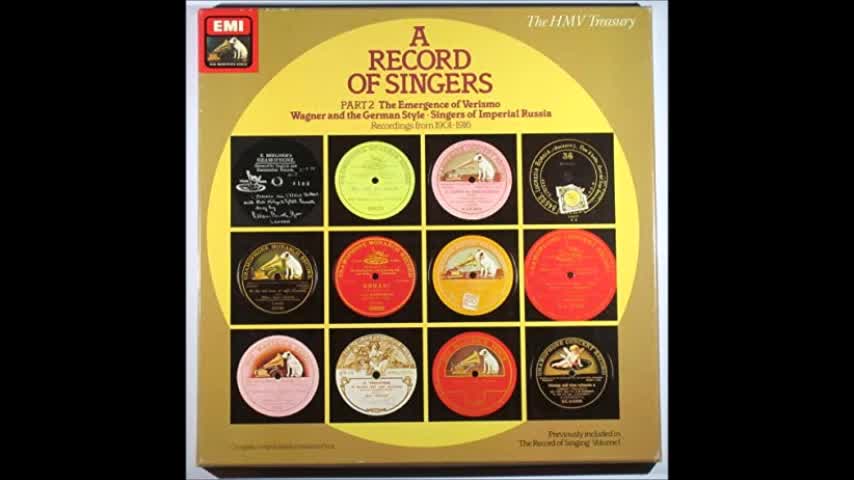Premium Only Content

A Record of Singers (EMI)1982 Record 11 (Volume 1) Part 2 1901-1916
Heldentenors
1 Hermann Winkelmann–
Dalibor - Blickst Du Mein Freund
Composed By – Smetana*
2 Erik Schmedes–
Tiefland - Pedro's Dream
Composed By – D'Albert*
3 Ernest Van Dyck–
Werther - Pourquoi Me Réveiller
Composed By – Massenet*
4 Andreas Dippel–
Lohengrin - Mein Lieber Schwan!
Composed By – Wagner*
5 Heinrich Knote–
Il Trovatore - Ah Si Ben Mio
Composed By – Verdi*
6 Karel Burrian–
Tristan Und Isolde - Wohin Nun Tristan Scheidet
Composed By – Wagner*
7 Alfred Von Bary–
Die Walküre - Siegmund Heiss Ich
Composed By – Wagner*
8 Wilhelm Herold*–
Fra Diavolo - Là C'est Un Grand Seigneur
Composed By – Auber*
9 Jacques Urlus–
Rienzi - Erstehe, Hohe Roma
Composed By – Wagner*
10 Leo Slezak–
Die Königin Von Saba - Magische Töne
Composed By – Goldmark*
11 Karl Jörn with Paul Knüpfer–
Martha - Ja, Seit Frühester Kindheit Tagen
Composed By – Flotow*
Lieder Singers - Tenors
12 Gustav Walter–
Schwanengesang - Am Meer
Composed By – Schubert*
13 Felix Senius–
Cosi Fan Tutte - Un'aura Amarosa
Composed By – Mozart*
Conductor – B. Weyersberg*
14 Karl Scheidemantel–
Tannhäuser - Als Du In Kühnem Sange
Composed By – Wagner*
Conductor – Bruno Seidler-Winkler
15 Baptist Hoffmann–
I Pagliacci - E Allor Perchè
Composed By – Leoncavallo*
16 Anton Van Rooy–
Die Walküre - Leb'wohl Du Kühnes, Herrliches Kind
Composed By – Wagner*
17 Theodor Bertram (2)–
Der Waffenschmied - Auch Ich War Eion Jüngling
Composed By – Lortzing*
18 Leon Rains with Minnie Nast–
Mignon - Légères Hirondelles
Composed By – Thomas*
Conductor – Künneke*
19 Leopold Demuth with Wilhelm Hesch–
Die Lustigen Weiber Von Windsor - Wie Freu' Ich Mich
Composed By – Nicolai*
The Record of Singing is a compilation of classical-music singing from the first half of the 20th century, the era of the 78-rpm record.
It was issued on LP (with accompanying books) by EMI, successor to the British company His Master's Voice (better known as HMV) — perhaps the leading organization in the early history of audio recording.
The project was accompanied initially by two illustrated books, containing singers' biographies and appraisals, which were published in London, by Duckworth, in the late 1970s. It covers the period running from circa 1900, when the earliest recordings were made, through until the early 1950s, when the last 78-rpm records were produced. Singers are divided into groups arranged according to national 'schools' and fach or voice type. In practice, this means that there are separate Italian, German, French, Anglo-American and East European classifications.
Origins
The original idea for the series came from the collector Vivian Liff, who chose the recordings used in the first two volumes, almost all of which came from the Stuart-Liff Collection, as well as the photographs of the singers which were published in the books that accompanied volumes 1 and 2 of the project. Michael Scott was asked to write these two books. They contained brief singers' biographies, too and featured a critical (sometimes controversial) commentary about their accomplishments, are gleaned from certain discs they had made. Bryan Crimp of EMI was responsible for the transfers of the original recorded material to LP. Keith Hardwick, however, was responsible for the transfers, etc., on the final two volumes of the survey (which were not accompanied by books).
Publication on LPs
EMI first released the collection on vinyl LP (long-playing) records.
Volume 1 first appeared in 1977, with a second edition in 1982 including corrections to the pitch of many of the recordings. The supplement also appeared around 1982. Volume 2 was published in 1979. Volume 3 and Volume 4 were released around 1984 and 1989 respectively.
The complete set was on 47 discs. Volumes 1, 2 and 3 each occupied 13, with Volume 4 having 8 discs. The original intention was apparently to produce 12 LPs per volume; but the selection of singers included in Volume 1 proved controversial, and an extra record (entitled a 'Supplement') was added to partly correct oversights. Volumes 2 and 3 were then assigned 13 records each.
Compact disc.
The collection was published with extensive documentation, including the numbers of the original recordings and full biographies of the singers.
The first two volumes were accompanied by books by Michael Scott:
• The Record of Singing to 1914, London, Duckworth, 1977, ISBN 978-0-7156-1030-5
• The Record of Singing Volume Two: 1914–1925, London, Duckworth, 1979, OCLC 6765624
They were republished in paperback by Northeastern University Press in 1993, ISBN 978-1-55553-163-8
(The books are still widely available from second hand book sellers.)
For more see: The Record of Singing - Wikipedia
-
 1:09
1:09
cwoodvet
4 years agoRBG record part 2
29 -
 1:10
1:10
KMGH
4 years agoA record day
99 -
 0:28
0:28
vlee66
4 years agoOld record player
141 -
 1:57
1:57
WXYZ
4 years agoRecord warm weekend
214 -
 0:36
0:36
WFTX
4 years agoRing breaks Guinness record
301 -
 6:27
6:27
Christian Writings
4 years agoThe Record of God
98 -
 2:20
2:20
WXYZ
4 years agoRecord breaking warmth
65 -
 44:40
44:40
Katie Miller Pod
7 hours ago $6.86 earnedEpisode 1 - Vice President JD Vance | The Katie Miller Podcast
63.6K15 -
 13:09:34
13:09:34
LFA TV
1 day agoLFA TV ALL DAY STREAM - MONDAY 8/11/25
244K22 -
 1:44:36
1:44:36
RiftTV
9 hours agoBREAKING: Trump FEDERALIZES D.C. To RESTORE Law & Order | The Rift | Ryan Matta, Olivia Krolczyk + Braeden Sorbo
73.9K17